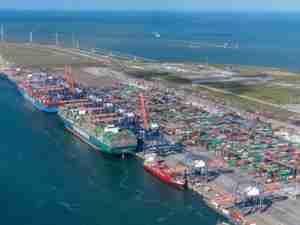During the Board of Commissioners meeting, Deputy Executive Director Susan Bass Levin briefed board members on the strategic business assessment, which began earlier this month and will be completed in early 2009.
The assessment will explore land use issues, including terminal capacity and space that may be needed to handle future cargo growth in a financially and environmentally sustainable manner. It also will look at cargo projections and ways to boost port productivity.
“With the demand for consumer goods rising and the construction of bigger ships under way, we must immediately plan the port’s future,” Ms. Bass Levin said. “This assessment will give us the tools we need to face port capacity issues head-on, and to make the strategic investments we need to ensure continuing cargo growth.”
Port Authority Chairman Anthony R. Coscia said, “The future success of our port and the region’s economy hinge on our ability to efficiently handle all of the cargo that wants to come here. Today our port is the leading East Coast destination for international shippers because of forward-looking investments we’ve made over the last few decades, and this study will help us to identify how to accommodate even greater volumes of cargo in the years ahead.”
Port Authority Executive Director Chris Ward said, “As previous studies have told us, our port cargo volumes are growing phenomenally – doubling over the next 10 years – and we need to plan for the future now. This assessment will help us to look outside the box and come up with innovative ways to handle more cargo on existing and new land. It will give us a road map on what we can do.”
To begin to plan for future land use, the Port Authority in March acquired 119 acres on the eastern end of the Port Jersey peninsula in Jersey City for redevelopment of new cargo container space. The property was added by purchasing the remaining years on Northeast Auto Terminal’s auto processing facility lease with the Port Authority.
With the changes taking place and the dramatic cargo growth in the Port of New York and New Jersey, an update of a previous study, completed in 2006, is required.
That study, the Comprehensive Port Improvement Plan, found that the port would not exceed five million teus (20-foot equivalent units) until 2015. The port surpassed that number in 2006. In 2007, the port handled 5.3 million teus.
The study also found that the port would handle approximately 674,000 vehicles by the year 2020. In 2007, the port handled 930,298 vehicles.
In its 2007-2016 Capital Plan, the Port Authority budgeted $2 billion for improvements to the port, including off-port road improvements, the completion of the ExpressRail system and the deepening of the harbor’s channels to 50 feet.
In conjunction with its port improvement program, the Port Authority has taken an aggressive role as environmental stewards of the New York Harbor. The agency’s program includes initiatives that have reduced greenhouse gas emissions related to port operations, such as the $600 million ExpressRail program to decrease the amount of cargo shipped by truck; the retrofitting of Staten Island ferries; modernization of on-port cargo-handling equipment to meet more stringent standards; the use of low-sulfur diesel fuel in this equipment, and projects to examine greener on-port vehicles.










